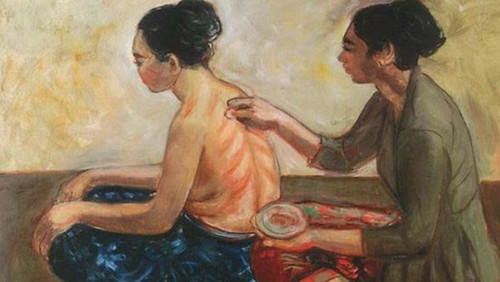
PREV ARTICLE
NEXT ARTICLE
FULL ISSUE
PREV FULL ISSUE
V25 2022 INDEX E-SYLUM ARCHIVE COINS IN MEDICINEAn American Numismatic Society Pocket Change blog by Jesse Kraft discusses an unusual use of coins in medicine. -Editor
Figure 1. Kerokan (Indonesian for
As numismatists, we know that coins have many, many functions and characteristics. Some of those are inherent from the time the coin is struck (such as a medium of exchange or as propaganda), while others may not arise until long after a particular coin is no longer in circulation (such as a tool for historians / archaeologists or as an alchemic timestamp for metallurgists). Other characteristics may not seem so straightforward, for instance, the use of coins in medicine. Coins have a very long history of medicinal usage. The Greek physician Hippocrates (the
Other medical treatments that involve coins, however, are not as risky or invasive and are even considered useful today. One of these is known as coin-sound. Coin-Sound is a diagnostic test that is used to determine whether or not an individual suffers from a punctured lung. A punctured lung can cause air or fluid to leak into the pleural cavity—the potential space between the pleural sac that surrounds each lung—known as pneumothorax (air) and hydrothorax (fluid), respectively. To test for this, a coin is held flat against the side of the patient's chest that is thought to be punctured, and tapped with a second coin. With a stethoscope on the direct opposite side of the patient, if there is fluid or air in the pleural cavity, the practitioner will hear a sound resonate, as opposed to quickly mute. At least one source necessitated the use of silver coins, in particular, in order to achieve the best results. Writing in 1898, Dr. C. F. Hoover described the sound as The sound itself is not produced by the pressure of the air or fluid that has entered the pleural cavity, nor is it the sound from the coins themselves. Rather, the sound comes from tension that is created on the bounding walls of the pressurized cavity. Under normal circumstances (with a negative pleural tension), the walls of the cavity are actually loose and under less tension than when the lung is collapsed. Once collapsed and air/fluid rushes in, the parietal pleura that is attached to the inner chest is stretched and tense, its elasticity heavily tested. Under these circumstances, the shockwave caused by the strike of the two coins held on the chest allows for the parietal pleura to vibrate and emit the sound on its own accord.
Armand Trousseau (1801–1867; Fig. 3) first observed and described coin-sound ca. 1857, which he called bruit d'arain, meaning Eventually, Trousseau's bruit d'arain was found useful for other ailments as well. For instance, using the same technique, cases of advanced tuberculosis can be diagnosed. However, instead of placed over a punctured lung, the coins must be placed over a pulmonary cavity that connects with a bronchial tube. Instead of a strong resonance, this peculiar sound (which is only heard while the patient's mouth is open) is said to resemble that of a cracked pot being struck with another piece of metal. Hence the name, cracked-pot resonance. While some of the medicinal uses of coins seem on the verge of wizardry, others have clearly proven to be practical. Throughout the late nineteenth and early twentieth centuries, coin-sound allowed for the ailments of many patients to become better understood and more efficiently diagnosed by doctors, thus easing the symptoms of their patients quicker than in earlier generations. Though replaced by more modern medicine, coin-sound was routine treatment for our forefathers. While the use of coinage in medicine was not part of their intended purpose, it is yet another function and characteristic that numismatists can apply to the study of money and expands our understanding of the many roles that coinage has played in our lives.
To read the complete article, see:
Wayne Homren, Editor The Numismatic Bibliomania Society is a non-profit organization promoting numismatic literature. See our web site at coinbooks.org. To submit items for publication in The E-Sylum, write to the Editor at this address: whomren@gmail.com To subscribe go to: https://my.binhost.com/lists/listinfo/esylum All Rights Reserved. NBS Home Page Contact the NBS webmaster 
|

